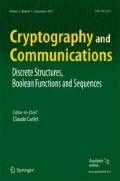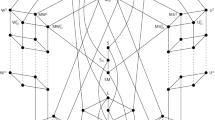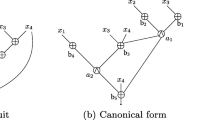Abstract
We show (almost) separation between certain important classes of Boolean functions. The technique that we use is to show that the total influence of functions in one class is less than the total influence of functions in the other class. In particular, we show (almost) separation of several classes of Boolean functions which have been studied in coding theory and cryptography from classes which have been studied in combinatorics and complexity theory.
Similar content being viewed by others
References
Boppana, R. B.: The average sensitivity of bounded-depth circuits. Inf. Process. Lett. 63(5), 257–261 (1997). https://doi.org/10.1016/S0020-0190(97)00131-2
Bruck, J.: Harmonic analysis of polynomial threshold functions. SIAM J. Discret. Math. 3(2), 168–177 (1990). https://doi.org/10.1137/0403015
Carlet, C.: On the nonlinearity of monotone Boolean functions. Cryptogr. Commun. 10(6), 1051–1061 (2018). https://doi.org/10.1007/s12095-017-0262-5
Carlet, C., Joyner, D., Stănică, P., Tang, D.: Cryptographic properties of monotone Boolean functions. J. Math. Cryptol. 10 (1), 1–14 (2016). http://www.degruyter.com/view/j/jmc.2016.10.issue-1/jmc-2014-0030/jmc-2014-0030.xmlhttp://www.degruyter.com/view/j/jmc.2016.10.issue-1/jmc-2014-0030/jmc-2014-0030.xml
Celerier, C., Joyner, D., Melles, C., Phillips, D.: On the Walsh-Hadamard transform of monotone Boolean functions. Tbilisi Math. J. 5(2), 19–35 (2012). https://projecteuclid.org/euclid.tbilisi/1528768900
Chakraborty, S., Karmalkar, S., Kundu, S., Lokam, S.V., Saurabh, N.: Fourier entropy-influence conjecture for random linear threshold functions. In: Latin American Symposium on Theoretical Informatics, vol. 10807, pp. 275–289. Springer. https://doi.org/10.1007/978-3-319-77404-6_21 (2018)
Chow, C.K.: On the characterization of threshold functions. In: 2nd Annual Symposium on Switching Circuit Theory and Logical Design (SWCT 1961). pp. 34–38. IEEE. https://ieeexplore.ieee.org/document/5397305 (1961)
Cusick, T.W., Stănică, P.: Cryptographic Boolean Functions and Applications. Academic Press, Cambridge (2017). https://www.elsevier.com/books/cryptographic-boolean-functions-and-applications/cusick/978-0-12-811129-1
Diakonikolas, I., Raghavendra, P., Servedio, R.A., Tan, L.: Average sensitivity and noise sensitivity of polynomial threshold functions. SIAM J. Comput. 43(1), 231–253 (2014). https://doi.org/10.1137/110855223
Gangopadhyay, S., Stănică, P.: Fourier entropy-influence conjecture for cryptographic Boolean functions. Trans. Adv. Res. (Special issue on Advances in Cryptology and Information Security) 12(2), 8–14 (2016). http://tar.ipsitransactions.org/
Gotsman, C., Linial, N.: Spectral properties of threshold functions. Combinatorica 14(1), 35–50 (1994). https://doi.org/10.1007/BF01305949
Håstad, J.T.: Computational limitations for small-depth circuits. MIT press, Cambridge (1987). https://mitpress.mit.edu/books/computational-limitations-small-depth-circuits
Kahn, J., Kalai, G., Linial, N.: The influence of variables on Boolean functions (extended abstract). In: [Proceedings 1988] 29th Annual Symposium on Foundations of Computer Science, pp. 68–80. IEEE Computer Society. https://doi.org/10.1109/SFCS.1988.21923 (1988)
Linial, N., Mansour, Y., Nisan, N.: Constant depth circuits, Fourier transform, and learnability. J. ACM (JACM) 40(3), 607–620 (1993). https://doi.org/10.1145/174130.174138
Preneel, B., Leekwijck, W.V., Linden, L.V., Govaerts, R., Vandewalle, J.: Propagation characteristics of Boolean functions. In: Advances in Cryptology - EUROCRYPT ’90, Workshop on the Theory and Application of of Cryptographic Techniques, vol. 473, pp. 161–173. Springer. https://doi.org/10.1007/3-540-46877-3_14 (1990)
Rothaus, O.S.: On “bent” functions. J. Comb. Theory Ser. A. 20 (3), 300–305 (1976). https://doi.org/10.1016/0097-3165(76)90024-8
Shalev, G.: On the Fourier entropy influence conjecture for extremal classes. arXiv:1806.03646 (2018)
Webster, A.F., Tavares, S.E.: On the design of S-boxes. In: Advances in Cryptology - CRYPTO ’85, Conference on the theory and application of cryptographic techniques, vol. 218, pp. 523–534. Springer. https://doi.org/10.1007/3-540-39799-X_41(1985)
Zhang, S.: Note on the average sensitivity of monotone Boolean functions. http://www.cse.cuhk.edu.hk/syzhang/papers/Sensitivity.pdf (2004)
Zheng, Y., Zhang, X.M.: Relationships between bent functions and complementary plateaued functions. In: International Conference on Information Security and Cryptology, pp. 60–75. Springer. https://link.springer.com/chapter/10.1007/10719994_6 (1999)
Acknowledgements
We thank the reviewers for their kind comments.
Author information
Authors and Affiliations
Corresponding author
Additional information
Publisher’s note
Springer Nature remains neutral with regard to jurisdictional claims in published maps and institutional affiliations.
Appendix A: Auto-correlation, influence and average sensitivity
Appendix A: Auto-correlation, influence and average sensitivity
Given an n-variable Boolean function f, its auto-correlation function \(C_{f}: \{-1, 1\}^{n} \rightarrow [-2^{n}, 2^{n}]\) is defined to be
where x ⊙u represents the pointwise multiplication of vectors x and u. The auto-correlation function is related to the influence in the following manner. For \(S\subseteq [n]\),
where \(\mathbf {w}_{S}=(w_{1},\ldots ,w_{n}) \in \{-1,1\}^{n}\) is such that wi = − 1 if i ∈ S and wi = 1 otherwise.
The sensitivity s(f,x) of a Boolean function f on input \(\mathbf {x} = (x_{1},x_{2},{\ldots } x_{n}) \in \{-1, 1\}^{n}\) is defined in the following manner.
The average sensitivity s(f) of f is given by
It is easy to see that I(f) = s(f) [14].
Rights and permissions
About this article
Cite this article
Biswas, A., Sarkar, P. Separation results for boolean function classes. Cryptogr. Commun. 13, 451–458 (2021). https://doi.org/10.1007/s12095-021-00488-w
Received:
Accepted:
Published:
Issue Date:
DOI: https://doi.org/10.1007/s12095-021-00488-w
Keywords
- Boolean function
- Total influence
- Monotone functions
- Bent functions
- Strict avalanche criterion
- Propagation characteristic
- Plateaued function
- Constant depth circuits
- Linear threshold function




